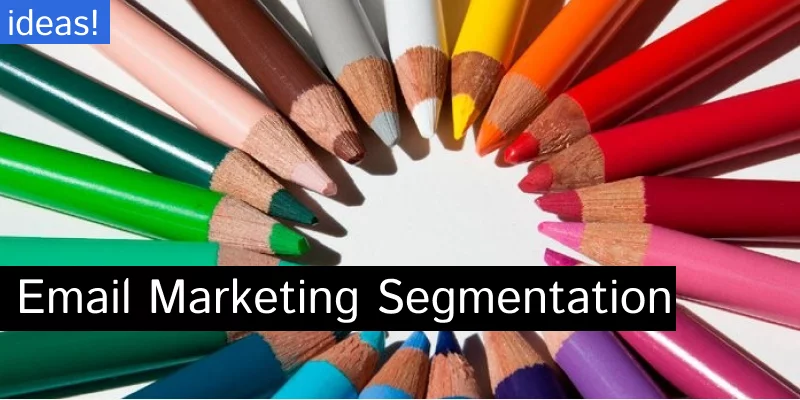In our previous blog posts, we talked about how you can be a successful ecommerce marketer by using email marketing.
In order to reach this objective, we were recommending you to spend some time for segmenting your target audience.
Of course, customer segmentation is important in every business.
But in ecommerce you have much more tools for segmenting your email recipients, which will help you get 30% higher email open rates and 50% higher click through rates. How much higher do you estimate your sales will be?
Segmenting your emailing database might take some time in the beginning, but it’s really worth the effort. We are here to give you a starting point by suggesting 7 customer segmentation criteria for improving your email marketing ROI.
1. Last purchase date
For example…
- Create a category of users who haven’t completed any purchase in the last month
- or segment your email subscribers in 3 categories: those who purchased before, after or exactly on a specific date (Black Friday for instance)
Why?
Because customers who did not purchase anything for a longer period of time might have forgotten about you. Send them an email reminder with a promotional code! In email marketing this segment is also known
2. Customer value
For example…
- See who your top 1% customers are according to cart value or to total amount spent
- or use the Pareto 20/80 principle. This says that 20% of your customers are generating 80% of your revenue.
Why?
Because your top customers are bringing you as much money as the bottom majority of them. You need to treat them accordingly and optimise their shopping experience as much as possible.
3. Loyalty
For example…
- You should decide by yourself what it means to be a loyal customer according to your ecommerce business specificity. Does it mean 2 purchases per year? Or 6? It’s your call!
- Make a dynamic list with your first time customers
Why?
Because loyal customers deserve, as well as your top customers, special treatment. But also first timers need another type of special attention: your email marketing strategy could focus on sending them more information about products, purchasing terms and other information which hopefully will convert them into recurrent buyers.
4. Lead sources
For example…
- Referrals from other websites
- Your own online campaigns
- Social media: Facebook, Twitter, Linkedin…you name it!
- Search engines: Google, Yahoo!, Bing etc.
- Direct visits
Why?
You can compare these segments to see if there are any specific particularities. Afterwards, you can start customizing your communication strategy, including email marketing, in order to have a better presence on the relevant channels. Maybe you need to insert social media buttons in your email designs. Or maybe you want to have a partnership with another website in order to conduct an emailing campaign targeting their subscribers.
5. Device type
For example…
- Are your customers completing purchases from a PC, a tablet or a smartphone?
- For a deeper segmentation, you can also split your customers into iOS, Android or Windows users.
Why?
Because you need to understand what is the shopping experience and behavior of your customers as well when they are looking on a big screen and using a mouse as when they are using their finger or a pen in order to push the “buy” button on a small display. Moreover, you might also be interested in the brand or operating system of the device. You might need to optimize your ecommerce website and your emails for the new touch-screen trend. And maybe even develop some mobile apps.
6. Email activity
For example…
- Email open rate
- Email click through rate
Why?
Because it helps you try different approaches in order to engage customers who never look at your emails. Or those who open them only to read the information, but never go a click further. Email marketing is often just trial and error. But you can play with the subject line, with the content and design of the emails you send to specific segments and see which strategy gets you an echo.
7. Demographic information
For example…
- Gender
- Age
- Income
- Location
Why?
Even if demographic segmentation is something very common, that makes it even more important. You know what they say: women are from Venus, men are from Mars. Different planets, different marketing strategy, different email approach!
You can be creative and figure out also other ways to segment your audience. Please share with us your ideas and questions in the comments below.
Do you like this article?
Join our CX for Retail dedicated newsletter!

Stay connected to what’s really important to optimize your digital revenues.
By clicking the button, you accept our Terms & Conditions. Also you will need to confirm your email address.
To give you most common categories for customer segmentation, here are the top 7:
- Demographic information: This can include factors such as age, gender, location, and income level.
- Purchase history: You can segment your email list based on what products or services customers have purchased in the past.
- Interests and preferences: You can use data from customer surveys or website interactions to segment your list based on interests and preferences.
- Engagement level: You can segment your list based on how engaged customers are with your emails, such as how frequently they open or click through your emails.
- Website behavior: You can use data from customer website interactions to segment your list based on factors such as how long they spend on your site, which pages they visit, and which products they view.
- Subscription type: You can segment your list based on how customers subscribed to your emails, such as through a sign-up form on your website or by purchasing a product.
- Customer lifecycle stage: You can segment your list based on where customers are in their journey with your brand, such as whether they are new customers or long-time loyalists.

